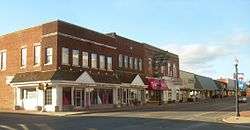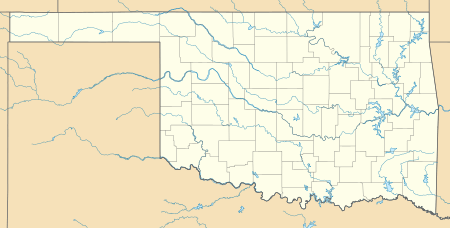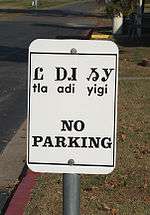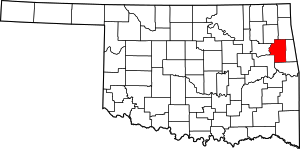Tahlequah, Oklahoma
Tahlequah (/ˈtæləkwɑː/ TAL-ə-kwah; Cherokee: ᏓᎵᏆ)[5] is a city in Cherokee County, Oklahoma, United States located at the foothills of the Ozark Mountains. It is part of the Green Country region of Oklahoma and was established as a capital of the 19th-century Cherokee Nation in 1839, as part of the new settlement in Indian Territory after the Cherokee Native Americans were forced west from the American Southeast on the Trail of Tears.
Tahlequah, Oklahoma | |
|---|---|
 Downtown Tahlequah | |
| Motto(s): "City Of Firsts" | |
 Location within Cherokee County and the state of Oklahoma | |
 Tahlequah Location in the United States  Tahlequah Tahlequah (the United States) | |
| Coordinates: 35°54′46″N 94°58′17″W | |
| Country | |
| State | |
| County | Cherokee |
| Cherokee Nation | founded 1838; second capital city |
| Government | |
| • Mayor | Sue Catron |
| Area | |
| • Total | 12.52 sq mi (32.43 km2) |
| • Land | 12.48 sq mi (32.33 km2) |
| • Water | 0.04 sq mi (0.10 km2) |
| Elevation | 797 ft (243 m) |
| Population | |
| • Total | 15,753 |
| • Estimate (2019)[3] | 16,819 |
| • Density | 1,347.35/sq mi (520.21/km2) |
| Time zone | UTC-6 (Central (CST)) |
| • Summer (DST) | UTC-5 (CDT) |
| ZIP codes | 74464-74465 |
| Area code(s) | 539/918 |
| FIPS code | 40-72100 [2] |
| GNIS feature ID | 1098721 [4] |
| Website | cityoftahlequah.com |
The city's population was 15,753 at the 2010 census, an increase of 8.96 percent from 14,458 at the 2000 census.[6] The 2019 estimated population is 16,819.[7]
Tahlequah is the capital of the two federally recognized Cherokee tribes based in Oklahoma, the modern Cherokee Nation and the United Keetoowah Band of Cherokee Indians. Tahlequah is also the county seat of Cherokee County.[8] The main campus of Northeastern State University is located in the city.
History
By 1842, Tahlequah was a growing community and already had four stores. The townsite of 160 acres was surveyed in 1843, and in the same year an intertribal council attracted ten thousand participants representing 21 different tribes. In 1844 the National Hotel was built, and the newspaper Cherokee Advocate issued its first edition using a printing press installed in the brand-new Supreme Court building. The first school opened in 1845, and the Tahlequah post office opened in 1847. The Cherokee Male Seminary opened in 1851, offering higher education to Cherokee boys who had already received their primary education.[9][lower-alpha 1]
Etymology


Many linguists believe the word 'Tahlequah' (Tah-le-quah) and the word 'Teh-li-co' are the same as 'di li gwa', the Cherokee word for grain or rice. (See Cherokee Nation Lexicon (dikaneisdi) at cherokee.org under culture/language). Scholars report the Cherokee word 'di li gwa' describes a type of native grain with a red hue that grew in the flat open areas of east Tennessee. One area, Great Tellico (Tellico Plains, Tennessee), was named for the grass with the red seed tops. Others interpret a word 'tel-i-quah' as 'plains'; however, there is no word for 'plains' in the Cherokee lexicon, and the word 'tel-i-quah' is not found in the lexicon. The idea that 'tahlequah' means 'plains' lends weight to the belief that the name refers to the wide open grassy areas of Great Tellico.
Local legend states the name is derived from Cherokee words 'ta-li' and 'ye-li-quu' meaning 'just two' or 'two is enough'. Supposedly three tribal elders had planned to meet to determine the location of the Cherokee Nation's permanent capital. Two elders arrived and waited for the third. As dusk approached, they decided that 'two is enough', or 'ta-li-ye-li-quu' which later became anglicanized to Tahlequah. According to tribal elders and Cherokee County elders, this legend first began to circulate in the 1930s. Tahlequah was a settlement as early as 1832. After the Western Cherokee agreed in 1834 to let the newer migrants settle near them, they joined their government with the Eastern Cherokee at Tahlequah in 1839. Tahlequah was named long before it was chosen as the Cherokee capital.
Cherokee Nation capital
In 1839, Tahlequah was designated the capital of ancestors of both the Cherokee Nation and the United Keetoowah Band of Cherokee Indians. Initially the government buildings were a complex of log or framed structures. Most of these buildings were destroyed during the Civil War, during which the Cherokee became divided into two bitterly opposing sides. The Cherokee Supreme Court Building, located in downtown Tahlequah and constructed in 1844, is the oldest public building in Oklahoma.[10]
Several markers of Cherokee and Native American heritage are found in town: street signs and business signs are noted in both the Cherokee language and English. Such signs use the syllabary created by Sequoyah, a Cherokee scholar of the 1820s who created the writing system.
Post Civil War rebuilding and development
After the war, a brick capitol was built and first occupied in 1870. In 1907, at the time of Oklahoma statehood, the building was converted into the Cherokee County courthouse. It was returned to the Cherokee Nation in 1970.[11]
In 1886, the first telephone company in Indian Territory was built. The Cherokee Female Seminary, which had originally been constructed in Park Hill, burned in 1887, and was rebuilt in Tahlequah. After statehood, it was taken over by the state to become Northeastern State Normal School and the Northeastern State Teachers College (now Northeastern State University). The first bank in the Cherokee Nation opened in 1891 on Muskogee Avenue.
A major fire destroyed much of downtown Tahlequah in 1895. The buildings destroyed were mostly wooden and were replaced with brick structures.
In 1902, the Ozark and Cherokee Central Railway [lower-alpha 2] built a line into Tahlequah.[11]
Tahlequah continued to grow. During the 1990s, it was the fourth fastest growing city in Oklahoma.
Geography
Tahlequah is located at 35°54′55″N 94°58′12″W (35.9153700, -94.9699560).[4] The city has a total area of 12.45 square miles (32.2 km2), all land.[13] The city is 40 miles (64 km) west of the Arkansas state line.
| Climate data for Tahlequah 1981-2010, extremes 1900-2008 | |||||||||||||
|---|---|---|---|---|---|---|---|---|---|---|---|---|---|
| Month | Jan | Feb | Mar | Apr | May | Jun | Jul | Aug | Sep | Oct | Nov | Dec | Year |
| Record high °F (°C) | 78 (26) |
88 (31) |
96 (36) |
94 (34) |
97 (36) |
108 (42) |
118 (48) |
118 (48) |
109 (43) |
98 (37) |
89 (32) |
80 (27) |
118 (48) |
| Average high °F (°C) | 49.0 (9.4) |
54.0 (12.2) |
63.4 (17.4) |
72.1 (22.3) |
78.5 (25.8) |
85.5 (29.7) |
90.8 (32.7) |
91.5 (33.1) |
83.5 (28.6) |
73.0 (22.8) |
61.4 (16.3) |
50.2 (10.1) |
71.1 (21.7) |
| Average low °F (°C) | 27.1 (−2.7) |
31.5 (−0.3) |
39.8 (4.3) |
48.4 (9.1) |
57.3 (14.1) |
65.0 (18.3) |
69.2 (20.7) |
68.1 (20.1) |
60.4 (15.8) |
49.5 (9.7) |
39.5 (4.2) |
29.5 (−1.4) |
48.8 (9.3) |
| Record low °F (°C) | −23 (−31) |
−13 (−25) |
−10 (−23) |
19 (−7) |
30 (−1) |
41 (5) |
40 (4) |
45 (7) |
28 (−2) |
16 (−9) |
6 (−14) |
−14 (−26) |
−23 (−31) |
| Average precipitation inches (mm) | 2.58 (66) |
2.65 (67) |
4.10 (104) |
4.03 (102) |
6.26 (159) |
5.20 (132) |
4.40 (112) |
3.87 (98) |
5.14 (131) |
4.61 (117) |
4.30 (109) |
3.09 (78) |
50.23 (1,275) |
| Average snowfall inches (cm) | 2.1 (5.3) |
1.9 (4.8) |
1.0 (2.5) |
0.0 (0.0) |
0.0 (0.0) |
0.0 (0.0) |
0.0 (0.0) |
0.0 (0.0) |
0.0 (0.0) |
0.0 (0.0) |
0.2 (0.51) |
0.9 (2.3) |
6.1 (15.41) |
| Average precipitation days (≥ 0.01 in) | 6 | 6 | 7 | 9 | 9 | 8 | 6 | 6 | 7 | 6 | 6 | 6 | 82 |
| Source: WRCC | |||||||||||||
Demographics
| Historical population | |||
|---|---|---|---|
| Census | Pop. | %± | |
| 1900 | 1,482 | — | |
| 1910 | 2,891 | 95.1% | |
| 1920 | 2,271 | −21.4% | |
| 1930 | 2,495 | 9.9% | |
| 1940 | 3,027 | 21.3% | |
| 1950 | 4,750 | 56.9% | |
| 1960 | 5,840 | 22.9% | |
| 1970 | 9,254 | 58.5% | |
| 1980 | 9,708 | 4.9% | |
| 1990 | 10,398 | 7.1% | |
| 2000 | 14,458 | 39.0% | |
| 2010 | 15,753 | 9.0% | |
| Est. 2019 | 16,819 | [3] | 6.8% |
| Sources: U.S. Decennial Census[6] | |||
As of the 2010 census,[6] there were 15,753 people, 6,111 households, and 3,351 families residing in the city. The population density was 1,312.75 per square mile (506.5/km2). There were 6,857 housing units at an average density of 571.4 per square mile (220.5/km2). The racial makeup of the city was 53.8% White, 2.4% African American, 30.0% Native American, 1.3% Asian, 0.0% Pacific Islander, 3.7% from other races, and 8.7% from two or more races. Hispanic or Latino of any race were 9.8% of the population.
Out of 6,111 households, 25.9% had children under the age of 18 living with them, 35.5% were married couples living together, 14.3% had a female householder with no husband present, and 45.2% were non-families. 34.3% of all households were made up of individuals and 10.9% had someone living alone who was 65 years of age or older. The average household size was 2.31 and the average family size was 2.99.
In the city, the population was spread out with 21.1% under the age of 18, 23.6% from 18 to 24, 24.3% from 25 to 44, 18.5% from 45 to 64, and 12.5% who were 65 years of age or older. The median age was 27.8 years. For every 100 females, there were 93.7 males. For every 100 females age 18 and over, there were 91.2 males.
As of 2013, the median household income was $29,114 and the median family income was $43,940. Males had a median income of $32,475 versus $27,939 for females. The per capita income for the city was $17,003. About 20.7% of families and 33.3% of the population were below the poverty line, including 43.2% of those under age 18 and 21.8% of those age 65 or over.[14]
Many people in Tahlequah speak Cherokee, and there is a Cherokee language immersion school in Tahlequah, Oklahoma, that educates students from pre-school through eighth grade with the Cherokee language as the medium of instruction, and no English.[15]
Education

Primary and secondary education
Education within the Tahlequah city limits consists of one early learning center serving students in Pre-K: Sequoyah; three elementary schools serving students in Kindergarten through 5th grade: Greenwood, Cherokee, and Heritage; one middle school with grades 6 through 8: Tahlequah Middle School; and one high school with grades 9-12: Tahlequah High School. Tahlequah High School serves as the main high school within the county as well and is fed by other rural Pre-K through 8th grade schools within Cherokee County.

The Cherokee language immersion school in Tahlequah, Oklahoma educates students from pre-school through eighth grade.[15] Because Oklahoma's official language is English, Cherokee immersion students are hindered when taking state-mandated tests because they have little competence in English.[16] The Department of Education of Oklahoma said that in 2012 state tests: 11% of the school's sixth-graders showed proficiency in math, and 25% showed proficiency in reading; 31% of the seventh-graders showed proficiency in math, and 87% showed proficiency in reading; 50% of the eighth-graders showed proficiency in math, and 78% showed proficiency in reading.[16] The Oklahoma Department of Education listed the charter school as a Targeted Intervention school, meaning the school was identified as a low-performing school but has not been identified as a Priority School.[16] Ultimately, the school made a C, or a 2.33 grade point average on the state's A-F report card system.[16] The report card shows the school getting an F in mathematics achievement and mathematics growth, a C in social studies achievement, a D in reading achievement, and an A in reading growth and student attendance.[16] “The C we made is tremendous,” said school principal Holly Davis, “[t]here is no English instruction in our school’s younger grades, and we gave them this test in English.”[16] She said she had anticipated the low grade because it was the school's first year as a state-funded charter school, and many students had difficulty with English.[16] Eighth graders who graduate from the Tahlequah immersion school are fluent speakers of the language, and they usually go on to attend Sequoyah High School where classes are taught in both English and Cherokee.
Colleges

Northeastern State University is the oldest institution of higher learning in the state of Oklahoma as well as one of the oldest institutions of higher learning west of the Mississippi River.[17] Tahlequah is home to the capital of the Cherokee Nation of Oklahoma and about 25 percent of the students at NSU identify themselves as American Indian.[18] The university has many courses focused on Native American linguistics, and offers Cherokee language Education as a major.[19] Cherokee can be studied as a second language, and some classes are taught in Cherokee for first language speakers as well.[20]
Culture
Cherokee National Supreme Court Museum
The building that once housed the Supreme Court of the Cherokee Nation has been converted into a museum and is open to the public. It reportedly is the oldest public building in Oklahoma.[10] [lower-alpha 3] It was constructed on the southeast corner of the town square by James S. Pierce in 1844. The first chief justice of the Cherokee Nation, John Martin (judge) (1784–1840) held court here. The printing press for the early-day Cherokee Phoenix newspaper was also located in this building, and a reproduction of the press and the newsroom can be seen here.[21]
Cherokee National History Museum
The former Cherokee National Capitol building was built on the town square in 1869. It contained the nation's executive and legislative offices until the tribal national government was dissolved in 1906, in preparation for Oklahoma's statehood. [lower-alpha 4] The building is listed on the National Register of Historic Places (NRHP) and is designated as a National Landmark.[22]
The museum contains 4,000 square feet (370 m2) of space for permanent exhibits and 1,000 square feet (93 m2) of rotating gallery space. Exhibits include not only works by Cherokee artists, but also artifacts loaned by the collections of the Cherokee Nation Archives, Gilcrease Museum, Smithsonian Institution and the Oklahoma Historical Society. Located at 101 South Muskogee Avenue in Tahlequah, the museum is normally open between 10 AM and 4 PM Tuesday through Saturday.[22]
Notable people
- Bill John Baker, former Principal Chief of the Cherokee Nation
- Roy Boney, Jr., animator, artist, graphic novelist, language advocate
- Tyler Bunch, puppeteer
- Robert J. Conley, author
- Butch Davis, head football coach, University of North Carolina (2007–2011), Former Head Coach, University of Miami (1995–2000)
- Bill Harrelson, Major League Baseball pitcher
- Murv Jacob, artist and illustrator, owned an art gallery and studio in Tahlequah for three decades, where he died.
- Stacy Leeds, tribal judge, Indian law professor, Dean of University of Arkansas School of Law
- Ronald G. Lewis, social worker and professor
- Wilma Mankiller, born in Tahlequah, first female Principal Chief of the Cherokee Nation
- Sonny Sixkiller, football player
- Chad "Corntassel" Smith, author, lawyer, and former Principal Chief of the Cherokee Nation
- Wes Studi, actor, born in Tahlequah
- Merle Travis, country singer and musician, 1917–1983; died at his home in Tahlequah
- Robert Presley, former Riverside County (CA) Undersheriff, California State Senator (1975-1995)
- Florence Owens Thompson, subject of Dorothea Lange's famous photograph Migrant Mother
In media
- Tahlequah is featured in the well-known book Where the Red Fern Grows and "Summer of the Monkeys" by Wilson Rawls.
- Tahlequah was once named as the fictional "home office" for the Top Ten Lists on Late Night with David Letterman.
- Tahlequah is mentioned several times in Mark Twain's 1892 novel The American Claimant as the origin of a bank robber named One-Armed Pete.
- Tahlequah is visited by the main characters in "Westward of the Law" by Matt Braun.
- Tahlequah is the principal location in Larry McMurtry's "Ned and Zeke".
- In The Burning Maze by Rick Riordan, Cherokee demigoddess Piper McLean relocates to Tahlequah.
- Starcarbon by Ellen Gilchrist takes place largely in Tahlequah.
Notes
- The Cherokee Female Seminary, which performed a parallel function for Cherokee girls, also opened in 1851 at Park Hill.[9]
- OCCR was soon afterwards bought by the St. Louis and San Francisco Railway (aka Frisco).[12]
- The museum is normally open 10 AM - 4 PM, Monday through Friday. The street address is 122 East Keetowah Street, Tahlequah.[21]
- The Supreme Court met in this building until 2018.[22]
References
- "2019 U.S. Gazetteer Files". United States Census Bureau. Retrieved July 28, 2020.
- "Census QuickFacts". United States Census Bureau. Archived from the original on 2014-12-27. Retrieved 2014-12-27.
- "Population and Housing Unit Estimates". United States Census Bureau. May 24, 2020. Retrieved May 27, 2020.
- "Geographic Names Information System". United States Geological Survey. Retrieved 2014-12-27.
- Cowen, Agnes Spade and Jane B. Noble. Comptemporary Cherokee Language Book. Tahlequah, OK: Heritage Printing, 1996: 77
- "Census of Population and Housing". United States Census Bureau. Retrieved 2014-12-27.
- "Population and Housing Unit Estimates". Retrieved May 21, 2020.
- "Find a County". National Association of Counties. Retrieved 2011-06-07.
- Harrington, Beth. "Tahlequah." Encyclopedia of Oklahoma History and Culture. 2009. Accessed November 8, 2019.
- Martindale, Robert. "Cherokee Nation places three historical buildings in trust", Tulsa World, 28 June 2003
- Harrington, Beth. "Tahlequah," Encyclopedia of Oklahoma History and Culture, 2009. Accessed March 30, 2015.
- Mullins, Jonita. "Three Forks History: Muskogee once served by five railroads." Muskogee Phoenix. November 28, 2015. Accessed November 8, 2019.
- "2010 Census Gazetteer". United States Census Bureau. Retrieved 2014-12-27.
- "2009-2013 American Community Survey: Economic Characteristics". United States Census Bureau. Retrieved 2014-12-27.
- Chavez, Will (April 5, 2012). "Immersion students win trophies at language fair". Cherokeephoenix.org. Retrieved April 8, 2013.
- "Cherokee Immersion School Strives to Save Tribal Language". Youth on Race. Archived from the original on July 3, 2014. Retrieved June 5, 2014.
- "General Information". NSU. Archived from the original on 2009-08-28. Retrieved 2008-02-20.
- Agnew, Brad. Encyclopedia of Oklahoma History and Culture. "Northeastern State University.""Archived copy". Archived from the original on 2012-11-19. Retrieved 2016-01-08.CS1 maint: archived copy as title (link)
- ' + auElement.html() + '. "NSU, Cherokee Nation Partner to Train and Hire Language Instructors - ICTMN.com". Indiancountrytodaymedianetwork.com. Retrieved 2015-07-17.
- "Cherokee". Ethnologue.
- "Cherokee National Supreme Court Museum." Trip Advisor. 2019. Accessed November 8, 2019.
- "Cherokee National History Museum." Visit Cherokee Nation. Undated. Accessed November 8, 2019.
External links
- City of Tahlequah
- Cherokee Nation
- United Keetoowah Band of Cherokee Indians
- Tahlequah Public Library
- Northeastern State University
- Northeastern State University Alumni Community
- Lakes Country 102.1FM
- Tahlequah Tourism
- The Pulse Magazine Tahlequah & Green Country Events & News
- Tahlequah information, photos and videos on TravelOK.com, official travel and tourism website for the State of Oklahoma
